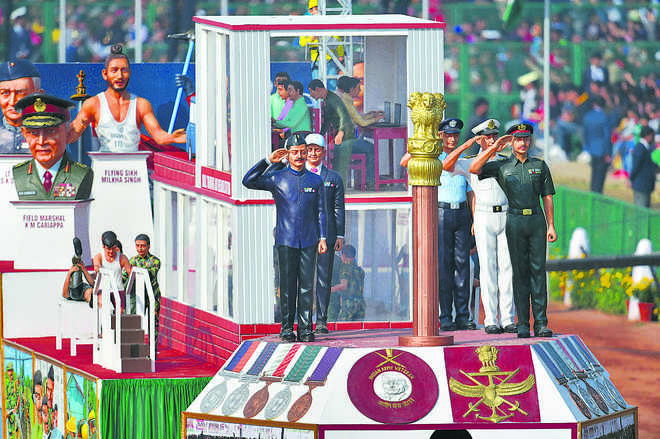
CRUNCH: Last year, the Centre had told the Lok Sabha that there was an overall shortage of 9,096 officers in the defence forces.
Col Mohinder Pal Singh (retd)
Defence commentator
WHILE the country applauds the actions of the defence forces on the borders, the citizens are largely unaware that each unit of the fighting and supporting arms of the Army are battling an acute shortage of officers. Some combat units are even staffed at a deficiency of 30 to 40 per cent. Last year, the Centre had told the Lok Sabha that there was an overall shortage of 9,096 officers in the defence forces — the Army (7,298), the Navy (1,606) and the Air Force (192).
This deficiency is at the level of junior officers commanding sub-units. It should not be seen in terms of percentages but in terms of the role each junior leader plays in combat. It’s imperative to know what role an officer plays in a combat or a non-combat unit and what it means at the grassroots level.
There are various methods of getting into the armed forces, starting from after Class XII in the NDA to the graduation level for the national academies and a host of other technical and non-technical entries. The entrance test for these officer-rank entries features a gruelling selection mechanism which culminates in a personality evaluation by services selection boards. Leadership traits are an important part of this evaluation. The pass percentage at the officer level is 2-5 per cent of the students who clear the written exam. After the selections, the trainees — generally referred to as ‘gentlemen cadets’ — undergo training at the elite academies, which develop them into leaders who are fit to take up the leadership role in combat and non-combat units. Those who are allotted the services are also made to undergo 1-2 years of attachment in the combat units, thus making them familiar with the operational environment.
Immediately on being commissioned, the young officers are assigned junior leadership roles in their sub-units — generally, a platoon/ troop commander or second-in-command of a company-equivalent sub-unit. Both require intelligence and maturity in handling the team of soldiers, some of whom are much senior to them in age and service. The young officers are supposed to soon get themselves integrated into the sub-units and get to ‘know their men’ whom they will command in real battle situations. They are made to go through many mock exercises and training in the sub-units to further strengthen the bond. Its only then that the men accept a leader to lead them. An unshakeable faith and obedience develop among them which enthuses them to even lay down their lives for the nation on his orders. As the officer becomes senior, he takes higher responsibilities and leads bigger units. The major deficiencies today are at the junior level.
Each officer has a role to play, a team to lead and there are no surplus or spare officers in any unit. Whenever there is a war, we have seen only two types of knee-jerk reactions in making up for the deficiency of officers — one, reduction in the training period of trainees at the Indian Military Academy (IMA) and commissioning them before the actual completion of training (this happened during the Kargil war). Such an action would provide at the most 500 or 600 officers, just enough to temporarily tide over the situation. Two, emergency commission, which means a full-scale drive to select additional officers and put them through training. The last such action was taken after the 1962 war. With this method, the shortage was quickly overcome; by the time the country faced the next conflict (1971), the officers’ strength was adequate.
Over the past 20 years, the Army’s commitment to counter-insurgency as well as the Siachen battlefield has been leading to fatal as well as non-fatal casualties, reducing the number of officers as well as men. The layman would wonder how the Army has been working all these years in spite of this deficiency. The answer is simple: for day-to-day banal work, it is done by the dual-tasking method. And as there has been no full-scale war since 1971, the situation has been managed like this. In a limited war like the one in Kargil, it’s understandable because at a particular point or place of conflict one can make up for the deficiency by quickly moving officers from unaffected sectors, but the same is not possible in a full-scale war. All our planning for weapons and equipment are for a two-front war. Both our major adversaries are not battling such junior leadership deficit. Today, our Army of 14 lakh needs an adequate number of officers to go into a two-front war at any time.
It is important to learn from history. After the 1962 war, the Army’s strength was being increased from 3.5 lakh to 8.25 lakh. Emergency commission was initiated; from November 1962 to October 1964, this deficiency was overcome. Officers’ training academies were established at Pune and Chennai in January 1963. Innovative schemes were introduced to recruit officers to the medical and engineering arms, including antedated seniority to cater to their length of service prior to commission, reservation of jobs in government service after release of emergency commission officers and university entry schemes. The Officers’ Training Academy at Pune was closed down in July 1964. A total of 9,000 officers were recruited and trained in a short span. The situation at present is no less grave and timely action must be initiated now. Recent steps such as restructuring of the Army Headquarters and a reduction of 20 per cent in the strength of 1,000 officers posted there are welcome. However, there is a need to take firm steps to fill the large number of vacancies. If it could be done over 50 years ago, it can be done much easily today when the young generation is willing to come forward to serve the nation.



























